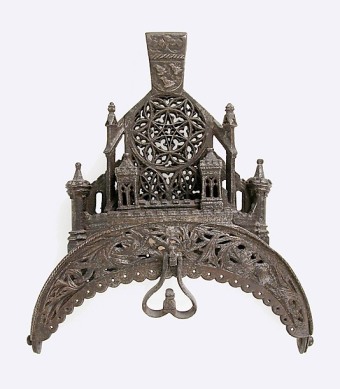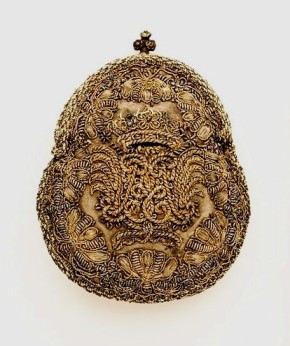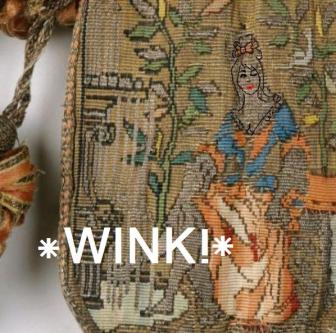Addicted to Trim: 17th Century Ribbon Loops
If you could describe the 17th century in one word, “swag” probably wouldn’t be the first to come to mind, but the term– which is American slang for “fashionable, ornamental excess”– actually describes the era particularly well, especially the use of trims and ribbons that swelled to ridiculous proportions by the 1650s. During the 17th century, trim became a major player in the fashion game. Early in the century, the fashion for all-over abundance of embroidery, metallic lace, and jewels was de rigueur for the upper class, but by 1610, different tastes were beginning to prevail: the iconic black silks and velvets with wide lace ruffs and collars we’ve come to associate with “pilgrim fashions” of the 17th century.
“Portrait of Mary Radclyffe” by William Larkin, circa 1610-13
This black-and-white world is a faux reality, since 17th century fashion was as brightly colored as any century before or after and was, perhaps, more heavily textured. However, solid colors including black, powder blue, pink, and yellow gowns and coats gained popularity over the polychrome brocades and embroidered smorgasbord of the late 1500s. During the 1600s, texture and volume became immensely important. It was no longer enough to throw on all your finery and be done with it. Textures had to compliment and contrast each other. If you wore a fitted black silk gown, you would contrast the smooth dark with a frilly, soft white lace. Rosettes, which had blossomed in popularity during the Elizabethan era, soared in popularity and offered a lady or gentleman yet another opportunity to play with texture. Rosettes of ribbon could be worn nearly anywhere: sleeves, garters, necklines, shoulders, belts, or shoes. Many rosettes were quite large, 6 inches in diameter or even larger!
Detail of “Amalia van Solms” by Sir Anthonis van Dyck, circa 1631
Notice how carefully “choreographed” the play of texture is on Amalia’s gown. The smooth silk bodice has ribboned sleeves which would reveal glimpses of an undersleeve. On top of that, golden rosettes tame the volume of and huge pinked cuffs soften the stark look. Her abundance of jewelry is symmetrically placed, contrasting with her offset belt rosette.
Rosettes are carefully sculpted into shape with folds and stitches, but when they become quite large, it’s much harder to control the stiffness and shape. Naturally, the rosette took on a softer incarnation, halfway between a rosette and a bow. It became fashionable to attach long aglets (metal tips) to the ends of the bows, adding yet another textural feature to the outfit. This popular embellishment could also be functional, tying sleeves to a bodice or stays, for example.
Loosely looped rosettes in “Portrait of a lady” by Jan Anthonisz van Ravesteyn, circa 1630-50
Doublet and Breeches Suit with loose bows, circa 1635-40
“The Cheat with the Ace of Clubs” by Georges de La Tour, circa 1630-34
Rosettes and bows were fashionable for both men and women. This painting, as well as the later version, show the aglet-tipped bows that exploded in popularity during the 1630s.
Stays and Sleeves with Metal Aglets, circa 1660-70
Perhaps the most interesting use of ribbon during the 17th century, however, was the ribbon loop. Developed out of the bows and loose rosettes, by the 1650s, these loops became the mark of the most fashionable, Cavalier gentleman. Cascades of these rustling ribbon loops were hung low around the waist to bridge the gap between relatively short doublet and high-waisted breeches.
Outfits belonging to Charles X (1622 to 1660)
These rich outfits were the height of fashion for men during the mid-17th century. The popular shape for men was a bowed-forward posture with thick limbs for a jaunty appearance. I’ve heard plenty of comments that these outfits make men look like toddlers since there is no strong waist delineation and the form is very puffy. However, the rounded appearance, coupled with large accessories like feathered hats, turned-down boots, and wide capes all served to make a man as large and grand looking as possible. The ribbon bows/loops added even more swagger and size to the picture.
Livery uniforms, circa 1672
Men weren’t the only ones to indulge in ribbon loops. Ladies closed their jacket fronts with a boa-like line of ribbons and hung ribbon tassels from their bodices and hair. By the 1670s, the loops had ceased to be distinctly bow-shaped and were applied like tassels. The ribbon strips were often wider for men and thinner for women and children.
“The Eldest Daughter of the Artist” by Claude Lefebvre, circa 1672
“Maria van Oosterwijck” by Wallerant Vaillant, circa 1671
This amazing woman became a floral still-life painter of great renown by her own volition at a time when painting flowers was a fine female occupation, but not one a woman was expected to do unmarried. Her paintings are bright, lifelike, and still quite collectable today. Her biography is well worth a read!
“Portrait of a Woman with a Moorish Page” by an unknown artist, late 17th century
“Elizabeth Freake and Baby Mary” by The Freake Limner, circa 1671-74
“Portrait of a Young Boy” by the studio of Henri Gascar, circa 1680-90
Note the matching ribbon puff attached to the hat.
Ribbon loops even trimmed hats, purses, and gloves. Anywhere embellishment could conceivably go, a swathe of looped ribbon could be–and often was– applied.
Gloves, circa 1660-80
Purse with ribbon loops and love symbolism, circa 1650-1700
The fashion for looped ribbons fell out of favor around 1700 as a new century rolled in and the fashion of choice changed from the full and voluminous Baroque silhouette to longer, leaner waistcoats for men and mantuas for ladies, eventually evolving into into the 18th century’s signature Rococo look with plenty of swag of its own.
“Marriage Portrait of Isaac Massa and Beatrix van der Laen” by Frans Hals, circa 1622
“Mr and Mrs Andrews” by Thomas Gainsborough, circa 1750
Learn more about 17th century fashion
“The 17th Century” on Wikipedia – Explore the expansive entry, including a fabulous world timeline, or skip straight to the fashions
“Passementarie” on Wikipedia – What the heck is that?! Find out.
“The 1660s Dress” by the Aristocat – View this lovely recreation of an 17th century gown from start to finish
“1660s Dress” on Rossetti – Another late 17th century style dress
For those of you who use Pinterest, there are a few lovely passementerie boards containing examples and tutorials here, here, and here.





































